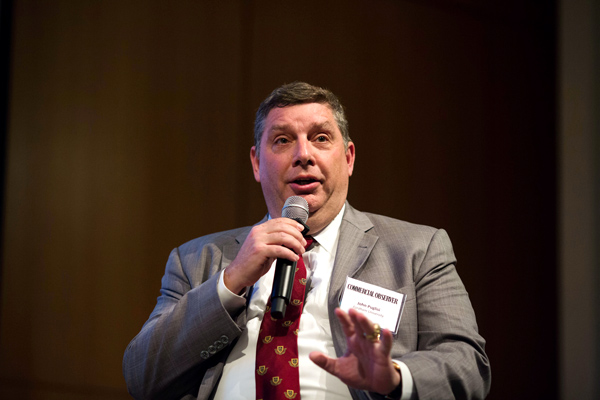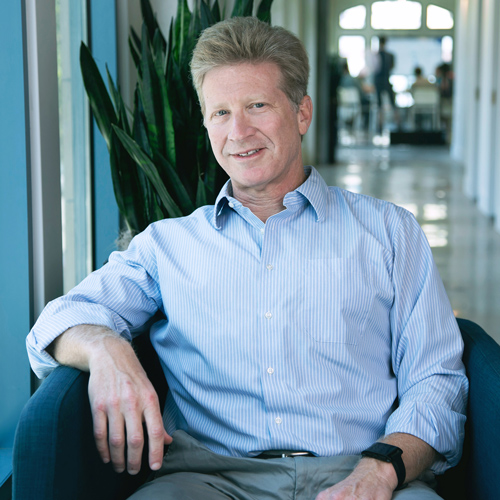Long before he joined the facilities-management department at Fordham University, the Jesuit university of New York City, John Puglisi worked as a design engineer for the water-consultancy firm Malcolm Pirnie, Inc. Now, he applies what he learned in consulting to his role as Fordham’s associate vice president of facilities management, especially when it comes to building strong partnerships with external vendors.
When Puglisi worked as a design engineer, many owners he worked with saw design as a commodity, and they saw Puglisi and his colleagues as resources rather than partners. “I thought we brought more value to it than that, so I try to maintain that in our perspective at Fordham,” he says. “If you need hours to do this task, tell me. I’m interested in making sure that your needs are met so that you can be a partner.”
Building lasting vendor relationships is vital to the consistent operation of Fordham’s two campuses. Puglisi sat down with American Builders Quarterly to share his approaches to making such partnerships successful.

You have developed lasting partnerships with many vendors, including HLW, AECOM Tishman, E-J Electric, and Caldwell & Walsh Building. What makes these partnerships so successful?
Each partner comes with different capabilities, and each circumstance is different. For instance, our relationship with E-J Electric came about because of their emergency-response capability. We were going through a patch on our campus in the Bronx where we were having cable failure almost once a year. It was a stressful situation, but E-J has a branch that does nothing but emergency response. Essentially I just picked up the phone, called them, and the generators arrived on-site. In a very stressful environment where you’re not quite ready to go when this stuff happens, E-J’s a one-stop shop. They folded right in with the campus environment, which is also an important part of partnerships that we have.
How so?
All these firms understand the difference between working a typical construction project and working on an active college campus with young people walking around. The campus is always operational, so we have expectations that our partners comport themselves in an appropriate manner for not only a university but also a Jesuit institution. We want them to enjoy being here, obviously, because we do. But it’s more than just that—it’s understanding our values, our constraints, and where we fit in.
Why is having a solid external team so important to the consistent operation and management of Fordham’s facilities?
It’s not necessarily the company; it’s more the people that they put forward and the people that you wind up working with. That’s where you really develop the partnership and the real relations, from my perspective of putting together teams. If you have the right attitude and the right people that know the big-picture issues, the details tend to take care of themselves.
How would you define a successful project?
We want a good finished project, but we also want a good experience throughout the project. We don’t have an awful lot of resources that we throw onto projects from an owner’s-involvement standpoint, so we need the process to flow smoothly. We don’t sit around and make demands without understanding impact. If we do that, we don’t get the experience that we’re looking for.
It sounds like it’s as much about the interpersonal relationships as it is about the work product. Would you say that’s true?
I know that builders take pride in their finished product, but I think they also take pride in the fact that they had a good experience. I know we do. I’m very proud of some of the buildings that we’ve worked on, but I’m even prouder that I can say that this was a good job for everybody involved and everybody got their expectations met or exceeded and they liked their experience here at Fordham. I think they go hand in hand. When a job isn’t a good experience, nine times out of ten the building quality is not there, either.
What’s the key to finding reliable vendors?
The ones that do come into a relationship with us generally come referred. One of our go-to contract plumbers right now came to us through one of our partners on a construction project. Our partners know how we do things and what we’re looking for, so a lot of times, our partners are our agents.
What are your best practices for developing effective partnerships?
We work hard on being a good owner. Sometimes that means getting out of the way. A lot of times that means making sure we take a commensurate amount of risk in the project. We try not to put our partners—our valued relationships—in positions where they can’t succeed.
How do you set your partners up for success?
If I have a constructor that tells me, “I can’t do a job unless I hold 10 percent contingency and I hold your money,” that’s not going to be how we do things. I’d like to know that before we start getting into contractual negotiations. If that’s a showstopper for them and it happens to be a showstopper for us, let’s just move on and find something else we can work together on that meets both of our requirements. A partnership is just that: meeting both teams’ expectations.


